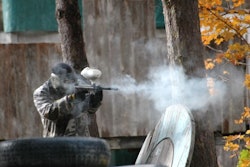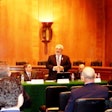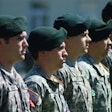Long before Pancho Villa rode the "frontera" (border area), bands of bandits and smugglers flourished there. The lure of gringo gold and greenbacks drew these men to traffic in contraband alcohol, guns and drugs.
Like the evolution of the Italian Mafia in U.S. cities such as New York and Chicago, Mexican smugglers or "contrabandistas" evolved from crude thuggish beginnings to more criminally sophisticated organized crime groups. Mexico's Chicago was the city of Culican in the state of Sinaloa. Many of Mexico's most infamous drug lords learned their trade there. If not physically, at least spiritually, it became the drug cartel capital.
If drug trafficking spawned the cartels, corruption was the mid-wife. And the "godfather" was the corrupt former Mexican judicial federal police agent, Miguel Angel Felix Gallardo. El Padrino (Godfather) had also been the body guard for the governor of Sinaloa and with the governors assistance he gained favor with the Sinaloan drug lord Pedro Aviles, who controlled territory stretching from Sinaloa to Chihuahua and the Texas border.
In September of 1978, Aviles was killed by Mexican federal police. Sinaloa had been the drug smugglers' marijuana and opium heaven since the roaring '20s. At the time, 10,000 Mexican soldiers were all over the state spraying the crop-destroying herbicide paraquat on the cash crops in Sinaloa, Durango and Chihuahua. "Operation Condor," as it was known, was supported by American aircraft.
El Padrino and fellow drug lords Rafael "Numero Uno" Caro Quintero and Ernesto "Don Neto" Fonseca relocated their operation to Guadalajara. The organization they founded became known as the Guadalajara Cartel. El Padrino had developed a close association with a Honduran cocaine supplier with ties to the King of Cocaine, Pablo Escobar, and the Columbian Medellin Cartel. This man, Juan Ramon Matta Ballesteros, provided the Guadalajara Cartel with abundant supplies of drugs from Colombia.
By the mid 1980s, the Guadalajara Cartel was smuggling two tons of cocaine a month into the U.S., according to DEA estimates. With his $30 million a month income, El Padrino Felix invested in tourist investments in Hermosillo and Puerto Vallarta.
But in November of 1984, the cartel took a $2 billion dollar loss when Mexican Federal Police, in cooperation with the U.S. Drug Enforcement Agency, raided Numero Uno Caro Quintero's property in Chihuahua and destroyed 10,000 tons of marihuana. This raid was part of the DEA's "Operation Godfather" which was headed by Special Agent Enrique "Kiki" Camarena.
On Feb. 7, 1985, the Guadalajara Cartel took its revenge. Camarena, born in the California border town of Calexico, and his pilot Alfredo Zavala were both kidnapped in broad daylight in Guadalajara. They were tortured, beaten to death and buried in shallow graves about 70 miles south of the city.
The brutal murder of Camarena and Zavala shocked the civilized world. American tourists were warned not to travel to Mexico; PTA members in the U.S. began wearing red ribbons to remember Kiki and remind children not to use drugs. In 1988, Congress declared the first Red Ribbon Week chaired by Nancy Reagan. The war on drugs had become a national security concern.
The story of the manhunt to capture or kill the cartel bosses who orchestrated the murder of Agent Camarena was depicted in a television mini-series produced by Michael Mann that's based on Elaine Shannon's book, "Drug Wars: The Camarena Story." It stars Steven Bauer (as Kiki), Craig Nelson and Treat Williams. Several Los Angeles County Sheriff's deputies, (including myself) were technical advisors and played bit parts.
Miguel "El Padrino" Felix, Mexico's Guadalajara Cartel founder, was arrested in 1989. He continued to run his huge drug trafficking organization (DTO) until he was moved to a Mexican maximum security prison in 1990. At that point, his sweeping organization was divided up by his former lieutenants. His nephews (seven Arellano-Felix brothers) established an organization on the border area in Tijuana.
Two of the Gallardo's top lieutenants, Hector Luis Palma Salazar and Joaquin "Chapo" Guzman Loera, established an organization in the drug capital of the state of Sinaloa. And so the Mexican DTOs of the Tijuana and Sinaloa Cartels were spawned.
It should be noted that it is common in Mexico to attach the mother's maiden name behind the father's family name. In the U.S., Miguel Angel Felix Gallardo would simply be called Miguel Felix. The eldest Arellano-Felix brother would be Francisco Arellano, and the Sinaloa lieutenants would be Hector Palma and Joaquin "Chapo" Guzman. I will refer to the subjects in the simpler manner when possible to assist the reader in recognizing the players.
A rivalry soon developed between the Sinaloa and Tijuana cartels. Competition for the lucrative plaza, drug gates and smuggler routes soon led to war. This was further complicated by temporary alliances and betrayals with other cartels; such as the Gulf and Juarez cartels.
The 2000 movie "Traffic" depicted part of the bloody conflict between the Arellano Felix brothers' Tijuana Cartel and the Carrillo Fuentes brothers' Juarez Cartel.
Editor's Note: Watch this space for the second part of Richard Valdemar's "Blood Brothers."





















